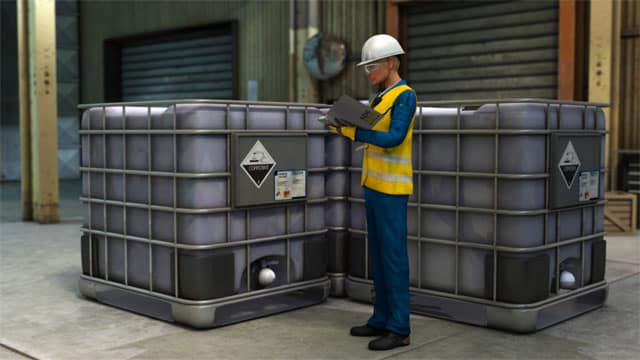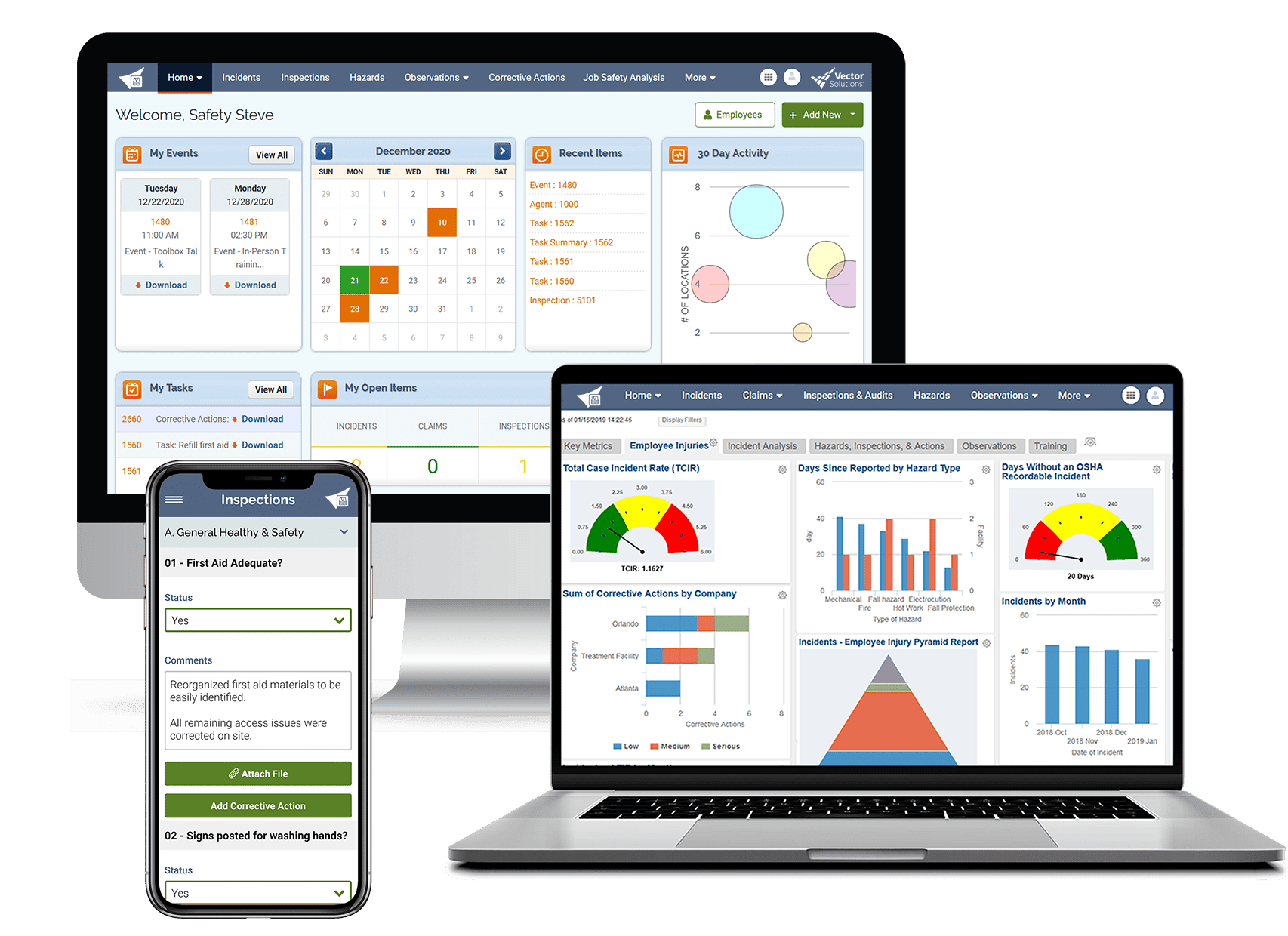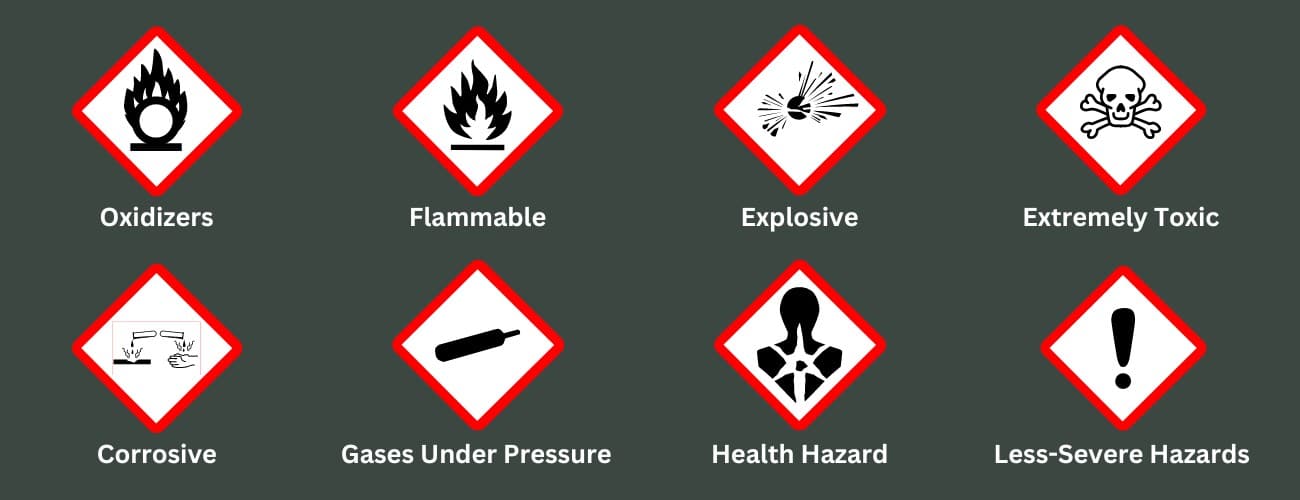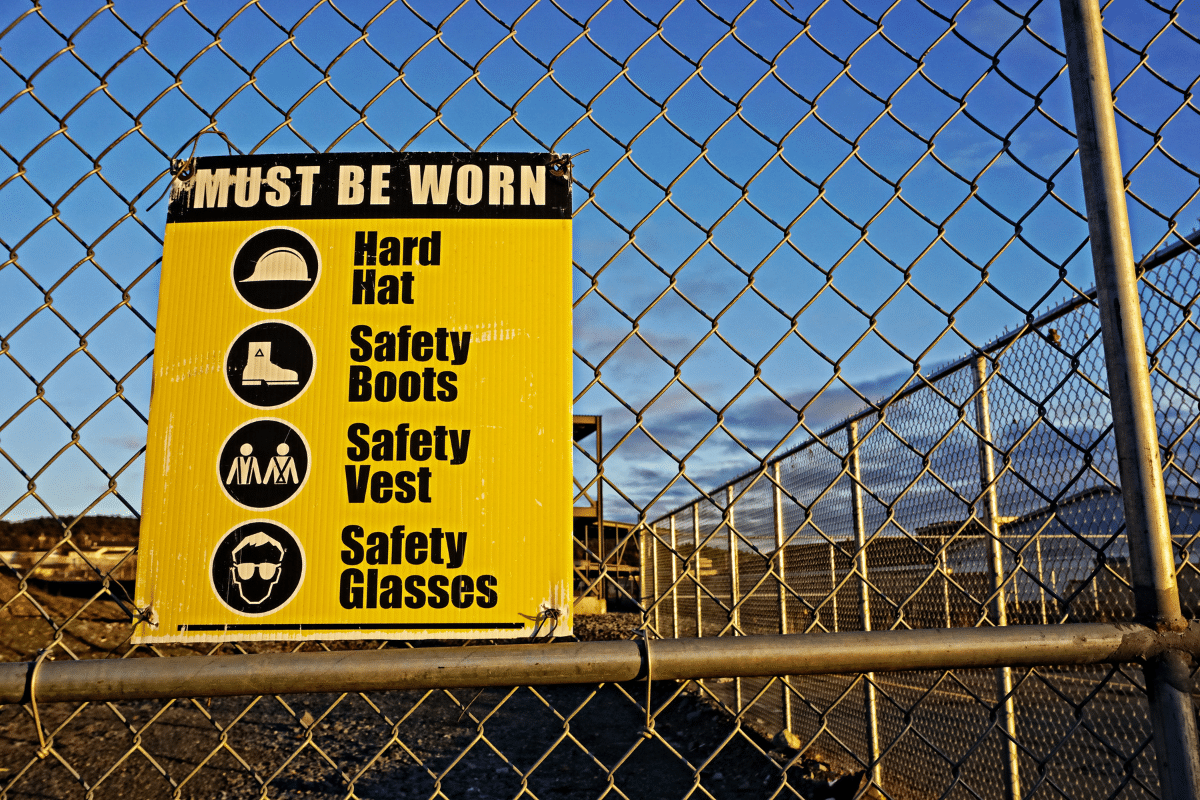March 1, 2024 9 min read

GHS Label Requirements, Symbols, and Classifications
Industry:
Solution:

Safe handling of chemicals is an important part of your EHS strategy. Teaching your workforce about label requirements, classifications, and correlating symbols is a great first step. So, in this guide, we’ll review everything you need to know about GHS chemical labels and proper chemical management.
What Are GHS Chemical Labels?
GHS is the acronym for the Globally Harmonized System of Classification and Labeling of Chemicals. GHS chemical labels are used to create a single standard for classifying and communicating about hazardous chemicals. These labels are required by OSHA to help ensure that people properly handle, store, and dispose of chemicals.
Filling out GHS Labels
So, how do you fill out these important labels? There are a few requirements:
- A signal word (e.g., “Danger” or “Warning”)
- GHS pictogram
- A hazard statement that defines the pictogram
- Manufacturer information, including contact information
- Precautionary statement (e.g., warnings and first aid information)
- Product identification (e.g., definition of chemical properties)
Note that a GHS label isn’t required when a substance of mixture is not classified as hazardous.
What is the Hazard Communication Standard?
The Hazard Communication Standard 1910.1200 is an OSHA rule that requires employers to provide their workforce with information and training about any hazardous chemicals they may be exposed to at work.
OSHA aligned this standard with GHS in 2012. Prior to these standards, numerous internal and external labeling systems existed, which led to confusion for workers, shipping delays, and lost revenue. These issues were exacerbated when shipping products across national borders, making a global standard for GHS chemical labels a critical need.
Moving to a harmonized GHS chemical labeling system allowed a uniform structure for labeling and disseminating hazard information. Today, over 83 countries share the GHS system. And while each have country-specific versions, the increasing use of the GHS worldwide has brought greater ease and transparency to chemical safety use and shipping.

GHS Chemical Labels and Haz-Com Safety Data Sheets
GHS alignment with the OSHA HazCom Standard was meant to be a practical approach to:
- Express and define health and physical hazards of chemicals. Environmental hazards of chemicals are also included in GHS, although these are outside of OSHA’s jurisdiction.
- Apply classification methods that use available data to define hazard criteria.
- Communicate hazard information in a uniform and systematic way on labels and Safety Data Sheets (SDS).
Two of the best places for workers to learn about the hazards of chemicals at the workplace are safety data sheets and GHS chemical labels.
Safety Data Sheets (SDSs)
As part of the GHS-alignment of OSHA’s Hazard Communication 2012 Standard, the old material safety data sheets (MSDSs) were dropped and new safety data sheets (SDSs) were integrated.
Safety Data Sheets are well-organized and comprehensive, with 16 different sections that are functional and easy to understand. As a result, the safety data sheet is the best place to look for in-depth explanations of the hazardous potential of a chemical at work.
SDSs serve as essential documents for ensuring workplace safety and health. Beyond detailing the hazardous properties of chemicals, SDSs:
- Provide crucial information on safe handling procedures, protective measures, and emergency responses in case of chemical exposure or accidents.
- Outline proper storage conditions, disposal methods, and regulatory compliance requirements, empowering employees with the knowledge needed to mitigate risks effectively.
By following the guidelines outlined in SDSs, organizations can enhance their chemical management practices, foster a safer work environment, and comply with regulatory standards.
GHS Chemical Labels Under HazCom 2012
Labels on chemical containers are smaller than a safety data sheet, so they can’t include as much information. But they do still include important safety information that is easily accessible, at the point of use, and easy to understand. Remember that labels are only meant as a fast reference for those who use, handle, transport, or store hazardous chemicals.
However, GHS chemical labels are critical in conveying essential safety information in a concise and easily understandable format. These labels feature standardized pictograms, signal words, hazard statements, and precautionary statements, providing immediate visual cues about the potential hazards associated with the chemical.
What Do GHS Chemical Labels Include?
The following elements are required on hazardous chemical labels:
- Supplier Identification. Name, Address and Telephone Number of the chemical manufacturer, importer, or other responsible party.
- Product Identifier: For example, the chemical name, code number, or batch number. The manufacturer can choose how to identify their product.
- Signal Words: These indicate the severity of the chemical hazards. There are two options for signal words: “Danger” and “Warning.”
- Danger indicates more severe hazards
- Warning indicates less serious hazards
- Hazard Statements: These are short statements that list physical, health, and environmental hazards of the chemical. Examples include “Extremely flammable liquid and vapor” or “Harmful if inhaled.” Hazard statements are standardized and selected by the chemical manufacturer based on the classification of the chemical. Each hazard statement has a code, which begins with the letter H and is followed by three digits. According to the HCS, only the hazard statement phrase is required for labeling. However, at the chemical manufacturer’s discretion, the code may appear on labels with the assigned hazard statement and is also featured on SDS.
- Precautionary Statements: These describe recommended measures to minimize or prevent adverse effects from exposure to or improper storage or handling of the chemical. There are four types of precautionary statements. Example: “Keep away from heat, spark and open flames.”
- Pictograms: These are graphic symbols used to communicate specific information about a chemical’s hazards. With their bright red, white and black color scheme, and clear graphics, pictograms stand out and serve as strong visual indicators of hazards.
Supplemental Information: In addition to these required label elements, chemical manufacturers may also include supplementary information, such as expiration dates, recommended PPE, or other pertinent details.
GHS Pictograms
There are nine pictograms in use on GHS chemical labels, but only eight of them fall under OSHA’s jurisdiction, as one is used for environmental hazards.
According to OSHA, “The required pictograms consist of a red square frame set at a point with a black hazard symbol on a white background, sufficiently wide to be clearly visible.”
The eight pictograms called for by OSHA’s HazCom Standard are shown below:

- Oxidizers: Materials that may combust when exposed to oxygen
- Flammable: Flammables, pyrophoric, self-heating, emits flammable gases, organic peroxides
- Explosive: Unstable explosives, explosives, self-reactive substances and mixtures, organic peroxides
- Extremely Toxic (Rapid Death): Acutely toxic chemicals and/or can cause rapid death
- Corrosive: Skin corrosion/burns, eye damage, corrosive to metals
- Gases Under Pressure: Gasses under pressure
- Health Hazard: Carcinogens, mutagenicity, reproductive toxicity, target organ toxicity, aspiration toxicity
- Less-Severe Hazards: Skin or eye irritant, limited acute toxicity, narcotic effects, respiratory tract irritant
More about Precautionary Statements
The four types of precautionary statements are:
- Prevention: Ways to minimize exposure
- Response: Actions to take for first aid, spills, exposures
- Storage: Methods to safely store the product, incompatible storage conditions
- Disposal: Safe disposal methods of product and containers containing residual product
Classification and GHS Chemical Label Creation
To create a product label, chemical manufacturers or importers/distributors must classify chemicals according to designated criteria that is outlined in the Hazard Communication Standard.
Chemical hazards for the updated HCS have three groups: health, physical, and environmental. Classification then is based upon 16 physical hazards, 10 health hazards, and two environmental hazards.
Each hazard classification is then further divided into categories, according to different severity levels. Categories are rated 1-4, with 1 being the most severe.
Many employers are familiar with the NFPA or the HMIS labeling systems, which applied a 0-4 rating hazard rating system, with zero being the lowest hazard and four as the most severe. These were the common GHS chemical labeling systems in use in US businesses for several decades. It’s important to note that the GHS uses an inverse rating system.
After the above steps, chemical manufacturers must compare those hazards found with Appendix C of the HCS and select the appropriate label elements.
HazCom Training for Employees Required by OSHA
OSHA spells out the requirements for Hazard Communication employee training in 1910.1200(h). They include the following:
- Employers must provide employee with information and training on hazardous chemicals in their work area at the time of their initial assignment and whenever a new chemical hazard that the employee has not previously been trained about is introduced into the work area.
- Information and training may be designed to cover categories of hazards or specific chemicals. Chemical-specific information must always be available through labels and safety data sheets.
The employee should be informed of:
- The requirements of 1910.1200(h)(2).
- Any operations in their work area where hazard chemicals are present.
- The location and availability of the organization’s written hazard communication program, including the list of hazardous chemicals at the workplace and the safety data sheets.
- Methods and observations that may be used to detect the presence or release of a hazardous chemical in the work area (such as monitoring conducted by the employer, continuous monitoring devices, visual appearance or odor of hazardous chemicals when being released, and more).
- The physical, health, simple asphyxiation, combustible dust, and pyrophoric gas hazards, as well as hazards not otherwise classified, of the chemicals in the work area.
- The measures employees can take to protect themselves from these hazards, including specific procedures the employer has implemented to protect employees from exposure to hazardous chemicals, such as appropriate work practices, emergency procedures, and personal protective equipment to be used.
- The details of the hazard communication program developed by the employer, including an explanation of the labels received on shipped containers and the workplace labeling system used by the employer; the safe data sheet, including the order of information and how the employees can obtain and use the appropriate hazard information.
Train Your Workforce on GHS Labels with Vector Solutions eLearning
Make sure your workers know the important aspects of GHS chemical labeling, SDS, and the new components of the GHS aligned HCS.
Vector Solutions offers the most complete library to cover all your training needs—from industrial skills training to health and safety, professional development, and more.
“At BASF, we value our people, safety, the environment, and our community. We are able to tie our values with Vector Solutions by ensuring we have good safety training and are able train new hires with the materials they need.”
Request a demo today to learn why chemical processing and industrial manufacturing companies trust vector solutions.
















